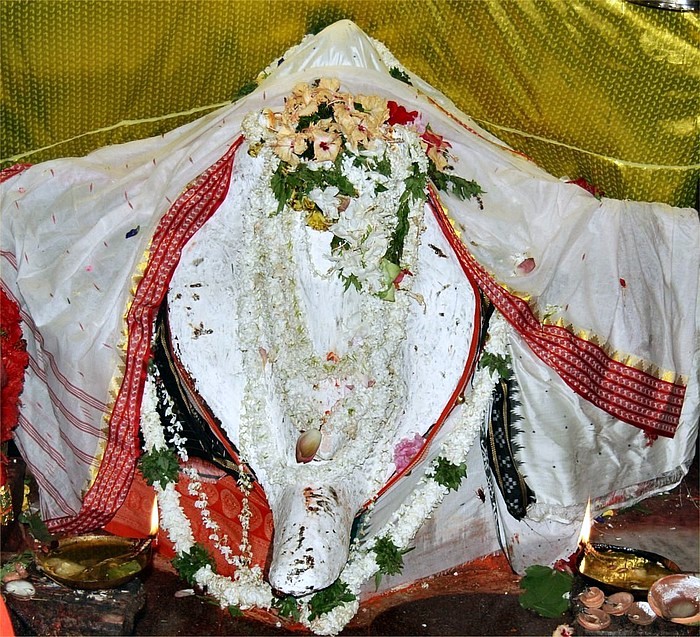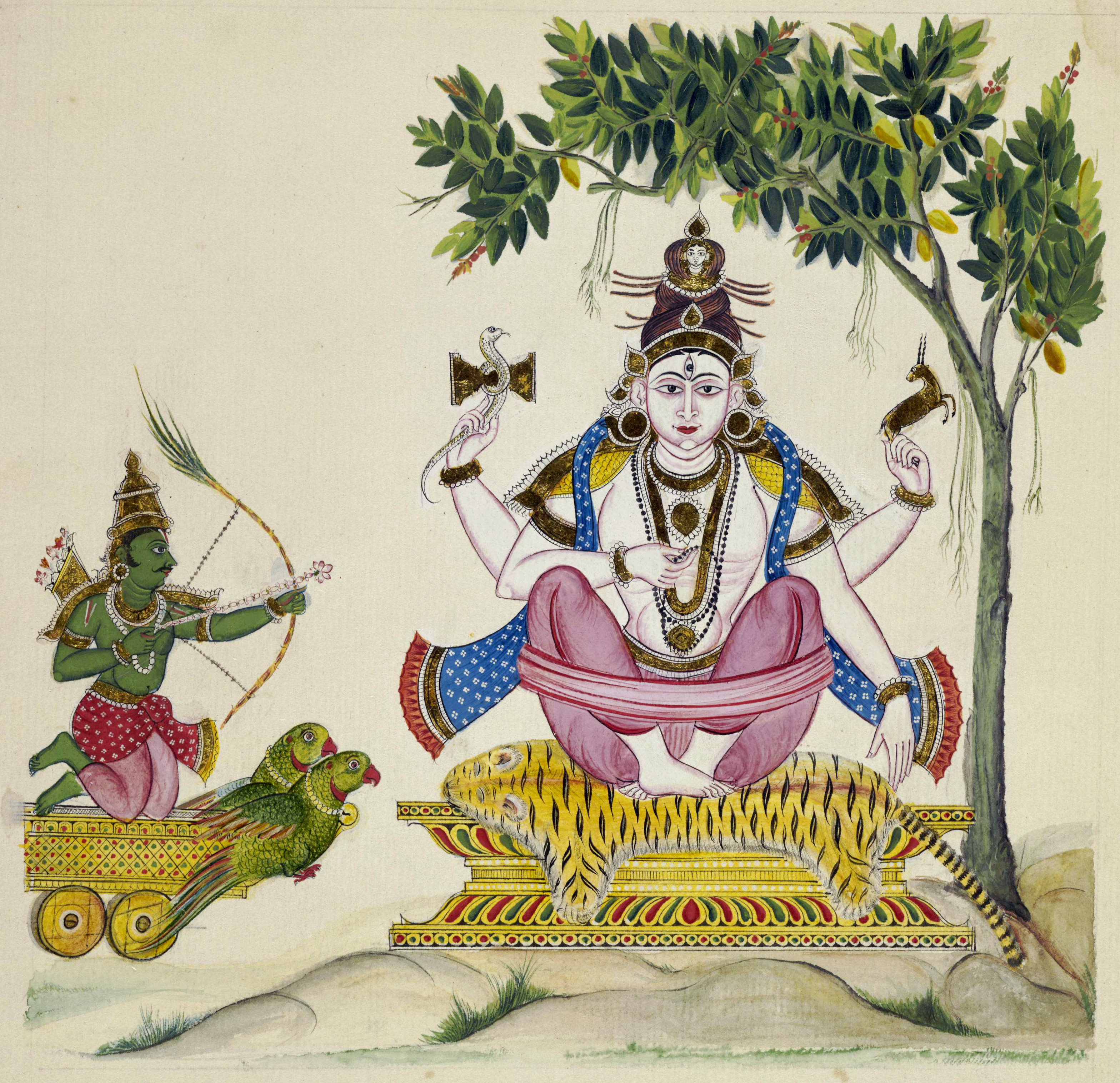|
Sitalsasthi
Shitalasasthi also known as Sital sasthi is celebrated as the marriage of Shiva and Parvati, a major festival of Utkal Brahmins (commonly called as Odia brahmans) and Aranyaka Brahmins (commonly called as Jhadua brahmans) since ages. It was started 400 years ago in Sambalpur after the king of Sambalpur brought Utkal Srotriya Vaidika Brahmins from brahmin sasana villages of Puri district. The localities of Nandapada are the oldest of these Brahmins. They first started Sitalsasti Utsav. This Hindu festival is in the form of a carnival where people and artists from different walks of life participate making it more beautiful and bringing out the true colours of life. Every year it is celebrated towards the end of the summer season (sixth day of the bright fortnight of the month of Jyestha), the aim being to call the rain Gods to give reprieve from the scorching heat of the Sun. During the carnival period, Sambalpur attracts tourists from nearby states and abroad also. Legend Sital ... [...More Info...] [...Related Items...] OR: [Wikipedia] [Google] [Baidu] |
Sambalpur
Sambalpur () is the fifth largest city in the Indian State of Odisha. It is located on the banks of river Mahanadi, with a population of 335,761 (as per 2011 census). Prehistoric settlements have been recorded there. It is the home of the Sambalpuri Saree. Overview The city contains many temples, historic buildings and parks. Educational institutes include Sambalpur University, Veer Surendra Sai Institute of Medical Sciences and Research (VIMSAR), Veer Surendra Sai University of Technology (VSSUT), Gangadhar Meher University, Indian Institute of Management Sambalpur and Odisha State Open University (OSOU). Hirakud Dam, the longest earthen dam in the world and the largest artificial lake of Asia, is at Sambalpur. After the independence of India, many commercial and government establishments sprung up in and around Sambalpur. It is a major railway junction of Odisha with the headquarters of Sambalpur Railway Division under the East Coast Railway Zone. National Highway 53, Nati ... [...More Info...] [...Related Items...] OR: [Wikipedia] [Google] [Baidu] |
Jyeshta
Jyeshtha or Jyēṣṭha ( sa, ज्येष्ठ; ne, जेठ ''jēṭ''; as, জেঠ ''zeth''; or, ଜ୍ୟେଷ୍ଠ ''Jyeṣṭha'') is a month of the Hindu calendar. In India's national civil calendar, Jyestha is the third month of the year. Known as ''Joishtho'' ( bn, জ্যৈষ্ঠ ''Jyôishţhô'') in Bengali, it is the second month of the Bengali calendar. In lunar religious calendars, Jyēṣṭha begins on the new moon and is the third month of the year. Traditionally, Jyēṣṭha is associated with high summer, and corresponds to May–JuneHenderson, Helene. (Ed.) (2005) ''Holidays, festivals, and celebrations of the world dictionary'' Third edition. Electronic edition. Detroit: Omnigraphics, p. xxix. in the Gregorian calendar. In Tamil, the month is known as Aani, the third month of the solar calendar that begins in mid-June. In Vedic Jyotish, Jyēṣṭha begins with the Sun's entry into Taurus, and is the second month of the year. In the ... [...More Info...] [...Related Items...] OR: [Wikipedia] [Google] [Baidu] |
Carnival
Carnival is a Catholic Christian festive season that occurs before the liturgical season of Lent. The main events typically occur during February or early March, during the period historically known as Shrovetide (or Pre-Lent). Carnival typically involves public celebrations, including events such as parades, public street parties and other entertainments, combining some elements of a circus. Elaborate costumes and masks allow people to set aside their everyday individuality and experience a heightened sense of social unity.Bakhtin, Mikhail. 1984. ''Rabelais and his world''. Translated by H. Iswolsky. Bloomington: Indiana University Press. Original edition, ''Tvorchestvo Fransua Rable i narodnaia kul'tura srednevekov'ia i Renessansa'', 1965. Participants often indulge in excessive consumption of alcohol, meat, and other foods that will be forgone during upcoming Lent. Traditionally, butter, milk, and other animal products were not consumed "excessively", rather, their st ... [...More Info...] [...Related Items...] OR: [Wikipedia] [Google] [Baidu] |
Shashti
Shashthi (Sanskrit: षष्ठी, ) also referred to as Chhath is the sixth day or tithi of a Paksha or fourteen-day phase of the moon. The word comes from the Sanskrit cardinal ''ṣaṣ'' (six), whence the ordinal number (linguistics) ''ṣaṣṭha'' (sixth), fem. ''ṣaṣṭhī'' (days of the paksha are feminine gender). The sixth tithi, especially in the waxing period (''shuklapaksha''), is important in several rituals including: * Durga Puja (September–October, east India, Bengal) * Sitalsasthi (May–June, Orissa, neighbouring regions) * Skanda (Kandha) Shashti or Subramanya Shashti (November–December, south India, Tamil Nadu) * Chandra Shashti (''Channan Chhath''): It is celebrated on Krishna Paksha Shahsti of Bhadrapada month. It is quite popular among Dogra community of Jammu division. The day is celebrated as birthday of Bhagwan Balarama and hence also called ''Balram Chhath'' or ''Baldev Chhath.'' * Surya Shashti (Chhath), a major sun-worshiping day of Hi ... [...More Info...] [...Related Items...] OR: [Wikipedia] [Google] [Baidu] |
Shukla Paksha
Paksha (also known as ''pakṣa''; sa, पक्ष, Nepal Bhasa: ''thwa'' and ''gа̄''; ) refers to a fortnight or a lunar phase in a month of the Hindu lunar calendar. Literally meaning "side", a paksha is the period either side of the Full Moon Day ('' Purnima''). A lunar month in the Hindu calendar has two fortnights, and begins with the New moon, ('' Amavasya''). The lunar days are called '' tithis'' and each month has 30 tithis, which may vary from 20 – 27 hours. A paksha has 15 tithis, which are calculated by a 12 degree motion of the Moon. The first fortnight between New Moon Day and Full Moon Day is called "Gaura Paksha" or Shukla Paksha () the period of the brightening moon ( waxing moon), and the second fortnight of the month is called "Vadhya Paksha" or Krishna Paksha (), the period of the fading moon ( waning moon). [...More Info...] [...Related Items...] OR: [Wikipedia] [Google] [Baidu] |
Vaishnava
Vaishnavism ( sa, वैष्णवसम्प्रदायः, Vaiṣṇavasampradāyaḥ) is one of the major Hindu denominations along with Shaivism, Shaktism, and Smartism. It is also called Vishnuism since it considers Vishnu as the sole supreme being leading all other Hindu deities, i.e. '' Mahavishnu''. Its followers are called Vaishnavites or ''Vaishnava''s (), and it includes sub-sects like Krishnaism and Ramaism, which consider Krishna and Rama as the supreme beings respectively. According to a 2010 estimate by Johnson and Grim, Vaishnavism is the largest Hindu sect, constituting about 641 million or 67.6% of Hindus. The ancient emergence of Vaishnavism is unclear, and broadly hypothesized as a fusion of various regional non-Vedic religions with Vishnu. A merger of several popular non-Vedic theistic traditions, particularly the Bhagavata cults of Vāsudeva-krishna and '' Gopala-Krishna'', and Narayana, developed in the 7th to 4th century BCE. It was i ... [...More Info...] [...Related Items...] OR: [Wikipedia] [Google] [Baidu] |
Kamadeva
Kama ( sa, काम, ), also known as Kamadeva and Manmatha, is the Hindu god of love and desire, often portrayed alongside his consort, Rati. The Atharva Veda regards Kamadeva as the wielder of the creative power of the universe, also describing him to have been "born at first, him neither the gods nor the fathers ever equalled". He is described to be attended by the celestial nymphs of Hindu mythology, the apsaras, depicted as a youthful deity of blue or red skin, decked with ornaments and flowers, armed with a bow of sugarcane and shooting arrows of flowers. His most popular legend is his story of incineration by Shiva's third eye while the latter was meditating, later embodied on earth as the eldest son of Krishna and his chief consort Rukmini, Pradyumna. Etymology and other names The name ''Kama-deva'' () can be translated as 'god of love'. ''Deva'' means heavenly or divine, and refers to a deity in Hinduism. ''Kama'' () means "desire" or "longing", especially as in sens ... [...More Info...] [...Related Items...] OR: [Wikipedia] [Google] [Baidu] |
Panchami
Panchami is the fifth day (tithi) of the fortnight (paksha) in Hindu lunar calendar. Festivals * Nag Panchami is a Hindu festival celebrated by Hindus in most parts of India. It is celebrated in Shravan month. On this day, people worship Nāga Devata (Cobras). People go to temples and snake pits and worship the snakes. They offer milk and silver jewelry to the Cobras to protect them from all evils. They also fast. This festival is to celebrate the day Lord Krishna defeated the serpent Kalia. On this day swings are put up in the village and people enjoy themselves. The married girls visit their parents during this occasion. * Vasant Panchami or Shree Panchami is a Hindu festival celebrating Saraswati, the goddess of knowledge, music and art. It is celebrated every year on the fifth day of the Indian month Magh (January–February), the first day of spring. Traditionally during this festival children are taught to write their first words; Brahmins are fed; ancestor worship (Pitr-tar ... [...More Info...] [...Related Items...] OR: [Wikipedia] [Google] [Baidu] |
Chowhan
Chauhan, historically ''Chahamana'', is a clan name historically associated with the various ruling Rajput families during the Medieval India in Rajasthan. Subclans Khichi, Hada, Songara, Bhadauria, Devda etc. are the branches or subclans of Chauhan Rajputs. Origin The word ''Chauhan'' is the vernacular form of the Sanskrit term ''Chahamana'' (IAST: Cāhamāna). Several Chauhan inscriptions name a legendary hero called Chahamana as their ancestor, but none of them state the period in which he lived. The earliest extant inscription that describes the origin of the Chauhans is the 1119 CE Sevadi inscription of Ratnapala, a ruler of the Naddula Chahamana dynasty. According to this inscription, the ancestor of the Chahamanas was born from the eye of Indra. The 1170 CE Bijolia rock inscription of the Shakambhari Chahamana king Someshvara states that his ancestor Samantaraja was born at Ahichchhatrapura (possibly modern Nagaur) in the gotra of sage Vatsa. The 1262 CE S ... [...More Info...] [...Related Items...] OR: [Wikipedia] [Google] [Baidu] |
Shiva
Shiva (; sa, शिव, lit=The Auspicious One, Śiva ), also known as Mahadeva (; ɐɦaːd̪eːʋɐ, or Hara, is one of the principal deities of Hinduism. He is the Supreme Being in Shaivism, one of the major traditions within Hinduism. Shiva is known as "The Destroyer" within the Trimurti, the Hindu trinity which also includes Brahma and Vishnu. In the Shaivite tradition, Shiva is the Supreme Lord who creates, protects and transforms the universe. In the goddess-oriented Shakta tradition, the Supreme Goddess ( Devi) is regarded as the energy and creative power (Shakti) and the equal complementary partner of Shiva. Shiva is one of the five equivalent deities in Panchayatana puja of the Smarta tradition of Hinduism. Shiva has many aspects, benevolent as well as fearsome. In benevolent aspects, he is depicted as an omniscient Yogi who lives an ascetic life on Mount Kailash as well as a householder with his wife Parvati and his three children, Ganesha, Ka ... [...More Info...] [...Related Items...] OR: [Wikipedia] [Google] [Baidu] |
Brahmin
Brahmin (; sa, ब्राह्मण, brāhmaṇa) is a varna as well as a caste within Hindu society. The Brahmins are designated as the priestly class as they serve as priests ( purohit, pandit, or pujari) and religious teachers (guru or acharya). The other three varnas are the Kshatriya, Vaishya and Shudra. The traditional occupation of Brahmins is that of priesthood at the Hindu temples or at socio-religious ceremonies, and rite of passage rituals such as solemnising a wedding with hymns and prayers.James Lochtefeld (2002), Brahmin, The Illustrated Encyclopedia of Hinduism, Vol. 1: A–M, Rosen Publishing, , page 125 Traditionally, the Brahmins are accorded the highest ritual status of the four social classes. Their livelihood is prescribed to be one of strict austerity and voluntary poverty ("A Brahmin should acquire what just suffices for the time, what he earns he should spend all that the same day"). In practice, Indian texts suggest that some Brahmins hist ... [...More Info...] [...Related Items...] OR: [Wikipedia] [Google] [Baidu] |





_Bhumi_Puja%2C_yajna.jpg)